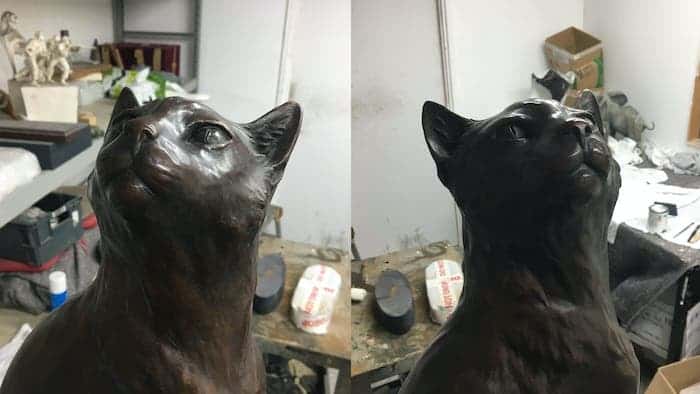
It was the year 1963 and the space race was in full swing. After significantly lagging behind its Soviet and American rivals, France was eager to prove itself as a space peer to the world’s then-two superpowers. By this time, it was already two years since Soviet cosmonaut Yuri Gagarin became the first human in space. Although late to the party, the French space agency made its first serious incursion into manned space flight on October 18, 1963 — the day a French cat named Félicette became the first and only feline to ever travel to space.
The story of the only space kitty in history
The feline hero was plucked from the streets of Paris by the Centre d’Enseignement et de Recherches de Médecine Aéronautique (CERMA), along with 13 other stray cats, all female since they were thought to have a calmer demeanor that would be better suited to the claustrophobic confines of a spaceship. For months, the catstronaut candidates endured months of grueling training, including confinement in small containers and withstanding hours in a restraint cloth. Like human astronauts, the cats also underwent dizzying multi-G-force spinning by a centrifuge to test the cats’ resilience at lift-off and re-entry.
All of the felines had permanent electrodes surgically implanted into their brains, so scientists could monitor their neurological activity, both during training and the journey in space.

However, only one cat out of the cosmic litter would be sent to space. From the six finalist candidates, a tuxedo cat with the designation “C 341” was chosen on launch day to board the French Véronique AG1 rocket, which was expected to soar from the Algerian Sahara Desert. Besides the electrodes fitted inside her skull, scientists also glued electrodes to C 341’s forward left and right rear legs to monitor cardiac activity and stimulate the cat during the flight.
In the early morning of October 18, 1963, launching from the Sahara Desert, the daring kitty finally reached sub-orbital space at an altitude of 152 kilometers (94 miles) during a flight that lasted 13 minutes, five minutes of which were pure weightlessness. The capsule that housed the cat plunged back to Earth, deployed its parachute, and safely touched down at the designated landing site where a helicopter was waiting to pick up the frightened, albeit healthy cat. Somewhat ironically, before this flight, France had so far only sent rats to space.
The mission was a resounding success and all of France cheered for the cat, now a national treasure. But the name C 341 — a code system that was chosen on purpose so the French scientists wouldn’t become attached to them — wasn’t fitting for a hero, so the French media quickly named her Félix, after the cartoon character, which was quickly changed to the feminine Félicette.
Yet despite people being proud and fond of her, Félicette’s story didn’t have a happy ending. Only two months after she came back from space, Félicette was euthanized so that researchers could examine her brain and study how space travel affected her body. The motivation for such a tragic task was seemingly noble. These were still the early days of space flight and scientists hoped to gather as much information as they could so as to make manned flights safer. But it’s not at all clear if Félicette’s autopsy rendered any useful intel and France never launched astronauts on its own rockets, though it produced ten astronauts that went to space as part of the European Space Agency (ESA), founded in 1973 with France as its first contributor.
Cherishing the memory of hero animals who lived during ethically-challenged times
Despite Félicette’s outstanding contributions to science, which ultimately cost her life, not a lot of people have heard of her. Félicette quickly faded out of the public’s consciousness, overshadowed by the much more famous Laika, the Soviet space dog who became the first animal to orbit Earth in 1957, or even Ham, the first Great Ape launched in space in 1961 by NASA. But the same can be said of the dozens of rats, mice, dogs, monkeys, and chimps sent into space by powers like the U.S., the Soviet Union, France and China, whom no one remembers anymore.
However, Félicette’s memory was rescued from obscurity thanks to the efforts of space enthusiast and all-round cat person Matthew Serge Guy, who launched a successful Kickstarter campaign in 2017 to build a memorial in honor of the space cat. The campaign gathered over 1,100 patrons who contributed $57,000 to honor Félicette with a five-foot-tall bronze statue designed by acclaimed sculptor Gill Parker.

The statue depicts Félicette perched atop planet Earth, gazing up toward the sky she once pierced on her way to space. It was unveiled on December 18, 2019, and is currently on display at the International Space University Campus in Strasbourg.

After the success of the Apollo moon landings, animals began to take a back seat in space exploration. Even so, animals like rabbits, frogs, snails, silkworms, bees, spiders, turtles, jellyfish, cockroaches, and of course the resilient tardigrades have been sent into space from the 1990s until quite recently. The service of these animals for space exploration cannot be overstated, with every astronaut landing safely back on Earth owing a great debt to them.
Here’s to Laika, Belka and Strelka the canines, Able and Baker the squirrel monkeys, Ham the chimp, Félicette the cat, Arabella and Anita the garden spiders, and all the dozens of other brave animals we now have to thank for safe space flight. Chapéu!


